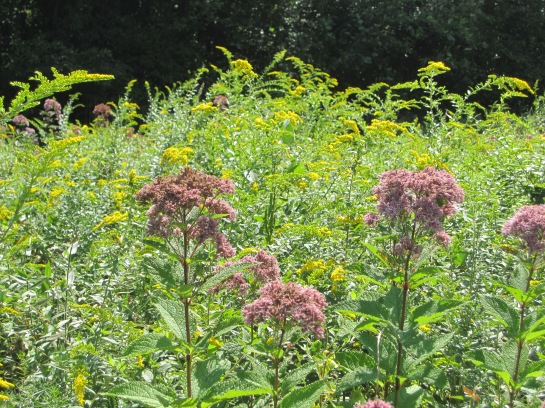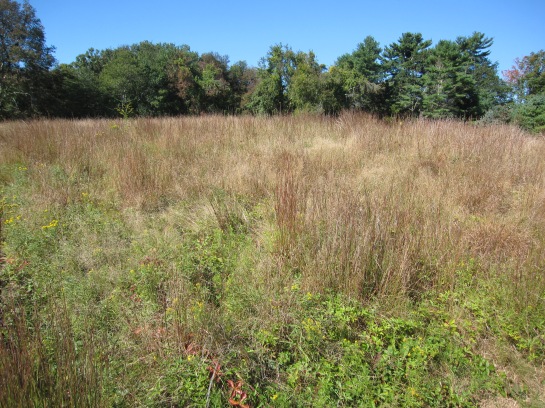The meadow experiment this year has been to mow only the paths.
That practice was most successful in meadow restoration terms in the boggiest areas where the Goldenrod and Joe Pye weed have grown into a dense mass of yellow and pink. Together they have squeezed out the Thistle and driven the invasives to a less visible position close to the ground. And the Dodder of last year has not returned. This section will get mowed before winter so the plants will not have to be disturbed in the spring. A fall mowing every other year may be just what the bog requires.
In the driest section of the field where the soil is the poorest, skipping a mowing in the spring seems to have made almost no difference: the warm season grasses that grow there have regrown on schedule. The poor soil seems to have kept succession in check. Perhaps a spring mowing every second year is what this “desert” needs.
Moving up the meadow, the ground slopes ever so slightly to the west and the soil must improve because cool season grasses crop up among the warm. Here the no-mow plan seems to have allowed for a gain for the forbs like these Black-eyed Susans which appeared for the first time in great masses this year.
The extra weeks of growing that the no-mow plan gave herbaceous plants allowed them to take over ground left after the Bittersweet succumbed to Triclopyr. Milkweed and Goldenrod but also Asters, Poke Weed, Pearly Everlasting, Agastache and (the non-native) Tansy took advantage of the opening.

The western end of the meadow that had been overrun by Bittersweet is now a jumble of herbaceous plants (with some Deer tongue grass) some might call weeds as it looks today.
The score after a season of the no-mow plan seems to be forbs one, graminoids zero. Neither the cool nor the warm season grasses appear to have spread with the no-mow plan. The real losers might be the invasives. (The meadow keeper hopes that Zeus is not reading this blog; he would be loading a thunderbolt with orange roots and berries for flinging directly next to the bee hives as recompense for such hubris). Bittersweet and Black Swallow wort appear to be on the decline though of course not gone.
There may be another loss, an aesthetic one. Mowing in the late spring knocks the cool season grasses and the herbaceous plants back giving the warm season grasses a break — just as it’s supposed to. Without that assist, Little Bluestem, Broom Sedge, Switch Grass and the other warm season native grasses will have have to share the stage with the less balletic Goldenrod when they start bowing with the fall breezes.
No-mow as a practice has come to an end. Management of the meadow will now follow a mowing schedule for each habitat of the field.




